
Ellora Caves
Encyclopedia
Ellora is an archaeological site, 30 km (18.6 mi) from the city of Aurangabad in the India
n state
of Maharashtra
built by the Rashtrakuta dynasty
. Well-known for its monumental caves, Ellora is a World Heritage Site
. Ellora represents the epitome of Indian rock-cut architecture. The 34 "caves" – actually structures excavated out of the vertical face of the Charanandri hills. Buddhist
, Hindu
and Jain
rock-cut temples and vihara
s and matha
s were built between the 5th century and 10th century. The 12 Buddhist (caves 1–12), 17 Hindu (caves 13–29) and 5 Jain (caves 30–34) caves, built in proximity, demonstrate the religious harmony prevalent during this period of Indian history.
These structures consist mostly of vihara
s or monasteries: large, multi-storeyed buildings carved into the mountain face, including living quarters, sleeping quarters, kitchens, and other rooms. Some of these monastery caves have shrines including carvings of Gautama Buddha
, bodhisattva
s and saints. In many of these caves, sculptors have endeavoured to give the stone the look of wood.
Most famous of the Buddhist caves is cave 10, a chaitya
hall (chandrashala
) or 'Vishvakarma cave', popularly known as the "Carpenter's Cave". Beyond its multi-storeyed entry is a cathedral-like stupa hall also known as chaitya, whose ceiling has been carved to give the impression of wooden beams. At the heart of this cave is a 15-foot statue of Buddha seated in a preaching pose. Amongst other Buddhist caves, all of the first nine (caves 1–9) are monasteries. The last two caves, Do Tal (cave 11) and Tin Tal (cave 12) have three stories.
 The Vishvakarma (Cave 10) is the only chaitya griha
The Vishvakarma (Cave 10) is the only chaitya griha
amongst the Buddhist group of caves. It is locally known as Vishvakarma or Sutar ka jhopda "carpenter's hut". It follows the pattern of construction of Caves 19 and 26 of Ajanta. On stylistic grounds, the date of construction of this cave is assigned to c.700. The chaitya once had a high screen wall, which is ruined at present. At the front is a rock-cut court, which is entered through a flight of steps. On either side are pillared porticos with chambers in their back walls. These were probably intended to have subsidiary shrines but not completed. The pillared verandah of the chaitya has a small shrine at either end and a single cell in the far end of the back wall. The corridor columns have massive squarish shafts and ghata-pallava (vase and foliage) capitals. The main hall is apsidal on plan and is divided in to a central nave and side aisles by 28 octagonal columns with plain bracket capitals. In the apsidal end of the chaitya hall is a stupa on the face of which a colossal 3.30 m high seated Buddha in vyakhyana mudra (teaching posture) is carved. A large Bodhi tree
is carved at the back. The hall has a vaulted roof in which ribs have been carved in the rock imitating the wooden ones.
period. The work first commenced in Caves 28, 27 and 19. These were followed by two most impressive caves constructed in the early phase - Caves 29 and 21. Along with these two, work was underway at Caves 20 and 26, and slightly later at Caves 17, 19 and 28. The caves 14, 15 and 16 were constructed during the Rashtrakuta
period. The work began in Caves 14 and 15 and culminated in Cave 16. All these structures represent a different style of creative vision and execution skills. Some were of such complexity that they required several generations of planning and co-ordination to complete.
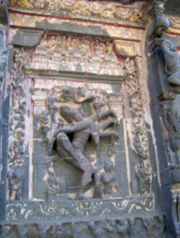
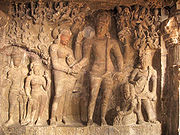
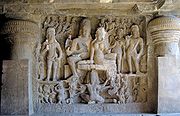 Cave 16, also known as the Kailasa or the Kailasanatha, is the unrivaled centerpiece of Ellora. This is designed to recall Mount Kailash
Cave 16, also known as the Kailasa or the Kailasanatha, is the unrivaled centerpiece of Ellora. This is designed to recall Mount Kailash
, the abode of Lord Shiva
– looks like a freestanding, multi-storeyed temple complex, but it was carved out of one single rock, and covers an area double the size of Parthenon
in Athens
. Initially the temple was covered with white plaster thus even more increasing the similarity to snow covered Mount Kailash.
All the carvings are done in more than one level. A two-storeyed gateway resembling a South Indian gopuram
opens to reveal a U-shaped courtyard. The courtyard is edged by columned galleries three storeys high. The galleries are punctuated by huge sculpted panels, and alcoves containing enormous sculptures of a variety of deities. Originally flying bridges of stone connected these galleries to central temple structures, but these have fallen.
Within the courtyard are three structures. As is traditional in Shiva temples, first is large image of the sacred bull Nandi
in the front of the central temple. Central temple - Nandi Mandap - is housing the lingam. Nandi Mandap stands on 16 pillars and is 29.3 m high. The base of the Nandi Mandap has been carved to suggest that life-sized elephants are holding the structure aloft. A living rock bridge connects the Nandi Mandap to the Shiva temple behind it. The temple itself is tall pyramidal structure reminiscent of a South India
n Dravidian
temple. The shrine – complete with pillars, windows, inner and outer rooms, gathering halls, and an enormous lingam at its heart – carved from living stone, is carved with niches, pilasters, windows as well as images of deities, mithunas (erotic male and female figures) and other figures. Most of the deities at the left of the entrance are Shaivaite (followers of Shiva) while on the right hand side the deities are Vaishnavaites (followers of Vishnu). There are two Dhvajastambhas (pillars with the flagstaff) in the courtyard. The grand sculpture of Ravana
attempting to lift Mount Kailasa, the abode of Lord Shiva, with his full might is a landmark in Indian art. The construction of this cave was a feat of human genius – it entailed removal of 200,000 tonnes of rock, and took 100 years to complete.
s of Vishnu. An inscription of grant of Dantidurga
is found on the back wall of the front mandapa. According to Coomaraswamy, the finest relief of this cave is the one depicting the death of Hiranyakashipu, where Vishnu in man-lion (Narasimha
) form, emerges from a pillar to lay a fatal hand upon the shoulder of Hiranyakashipu.
at the entrance and the Dhumar Lena (Cave 29) whose design is similar to the cave temple on Elephanta Island
near Mumbai. Two other caves, the Ravan ki Khai (Cave 14) and the Nilkantha (Cave 22) also have several sculptures. The rest of the Hindu caves, which include the Kumbharvada (Cave 25) and the Gopilena (Cave 27) have no significant sculptures.
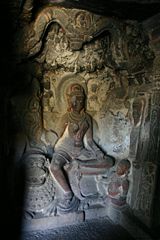
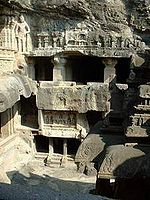 The five Jain caves at Ellora belong to the ninth and tenth centuries. They all belong to the Digambara sect. Jain caves reveal specific dimensions of Jain philosophy
The five Jain caves at Ellora belong to the ninth and tenth centuries. They all belong to the Digambara sect. Jain caves reveal specific dimensions of Jain philosophy
and tradition. They reflect a strict sense of asceticism
– they are not relatively large as compared to others, but they present exceptionally detailed art works. The most remarkable Jain shrines are the Chhota Kailash (cave 30), the Indra Sabha (cave 32) and the Jagannath Sabha (cave 33). Cave 31 is an unfinished four-pillared hall and a shrine. Cave 34 is a small cave, which can be approached through an opening on the left side of Cave 33.
flower on the ceiling. It got the appellation "Indra Sabha" probably it is significantly ornate and also because of the sculpture of the yaksha
(dedicated attendant deity) Matanga
on an elephant, which was wrongly identified as that of Indra
. On the upper level of the double-storied shrine excavated at the rear of the court, an imposing image of Ambika
, the yakshini
of Neminath
, is found seated on her lion under a mango tree, laden with fruits.
India
India , officially the Republic of India , is a country in South Asia. It is the seventh-largest country by geographical area, the second-most populous country with over 1.2 billion people, and the most populous democracy in the world...
n state
States and territories of India
India is a federal union of states comprising twenty-eight states and seven union territories. The states and territories are further subdivided into districts and so on.-List of states and territories:...
of Maharashtra
Maharashtra
Maharashtra is a state located in India. It is the second most populous after Uttar Pradesh and third largest state by area in India...
built by the Rashtrakuta dynasty
Rashtrakuta Dynasty
The Rashtrakuta Empire was a royal dynasty ruling large parts of the Indian Subcontinent between the sixth and the 10th centuries. During this period they ruled as several closely related, but individual clans. Rastrakutas in inscriptions represented as descendants of Satyaki, a Yadava well known...
. Well-known for its monumental caves, Ellora is a World Heritage Site
World Heritage Site
A UNESCO World Heritage Site is a place that is listed by the UNESCO as of special cultural or physical significance...
. Ellora represents the epitome of Indian rock-cut architecture. The 34 "caves" – actually structures excavated out of the vertical face of the Charanandri hills. Buddhist
Buddhism
Buddhism is a religion and philosophy encompassing a variety of traditions, beliefs and practices, largely based on teachings attributed to Siddhartha Gautama, commonly known as the Buddha . The Buddha lived and taught in the northeastern Indian subcontinent some time between the 6th and 4th...
, Hindu
Hinduism
Hinduism is the predominant and indigenous religious tradition of the Indian Subcontinent. Hinduism is known to its followers as , amongst many other expressions...
and Jain
Jainism
Jainism is an Indian religion that prescribes a path of non-violence towards all living beings. Its philosophy and practice emphasize the necessity of self-effort to move the soul towards divine consciousness and liberation. Any soul that has conquered its own inner enemies and achieved the state...
rock-cut temples and vihara
Vihara
Vihara is the Sanskrit and Pali term for a Buddhist monastery. It originally meant "a secluded place in which to walk", and referred to "dwellings" or "refuges" used by wandering monks during the rainy season....
s and matha
Matha
A matha ) is a term for monastic and similar religious establishments of Hinduism and Jainism. A matha is usually more formal, hierarchical, and rule-based than an ashram.-Advaita Mathas:...
s were built between the 5th century and 10th century. The 12 Buddhist (caves 1–12), 17 Hindu (caves 13–29) and 5 Jain (caves 30–34) caves, built in proximity, demonstrate the religious harmony prevalent during this period of Indian history.
The Buddhist caves
These caves were built during the 5th-7th century. It was initially thought that the Buddhist caves were one of the earliest structures, created between the fifth and eighth centuries, with caves 1-5 in the first phase (400-600) and 6-12 in the later phase (mid 7th-mid 8th), but now it is clear to the modern scholars that some of the Hindu caves (27,29,21,28,19,26,20,17 and 14) precede these caves. The earliest Buddhist cave is Cave 6, followed by 5,2,3,5 (right wing), 4,7,8,10 and 9. Caves 11 and 12 were the last. All the Buddhist caves were constructed between 630-700.These structures consist mostly of vihara
Vihara
Vihara is the Sanskrit and Pali term for a Buddhist monastery. It originally meant "a secluded place in which to walk", and referred to "dwellings" or "refuges" used by wandering monks during the rainy season....
s or monasteries: large, multi-storeyed buildings carved into the mountain face, including living quarters, sleeping quarters, kitchens, and other rooms. Some of these monastery caves have shrines including carvings of Gautama Buddha
Gautama Buddha
Siddhārtha Gautama was a spiritual teacher from the Indian subcontinent, on whose teachings Buddhism was founded. In most Buddhist traditions, he is regarded as the Supreme Buddha Siddhārtha Gautama (Sanskrit: सिद्धार्थ गौतम; Pali: Siddhattha Gotama) was a spiritual teacher from the Indian...
, bodhisattva
Bodhisattva
In Buddhism, a bodhisattva is either an enlightened existence or an enlightenment-being or, given the variant Sanskrit spelling satva rather than sattva, "heroic-minded one for enlightenment ." The Pali term has sometimes been translated as "wisdom-being," although in modern publications, and...
s and saints. In many of these caves, sculptors have endeavoured to give the stone the look of wood.
Most famous of the Buddhist caves is cave 10, a chaitya
Chaitya
A chaitya is a Buddhist or Jain shrine including a stupa. In modern texts on Indian architecture, the term chaitya-griha is often used to denote assembly or prayer hall that houses a stupa.-History:...
hall (chandrashala
Chandrashala
Chandrashala is the term most often used to describe the circular or horseshoe arch that decorates so many Indian cave temples and shrines. The arch is shaped like the cross-section of a barrel vault. When used on the facade of a chaitya hall, it is called a chaitya arch...
) or 'Vishvakarma cave', popularly known as the "Carpenter's Cave". Beyond its multi-storeyed entry is a cathedral-like stupa hall also known as chaitya, whose ceiling has been carved to give the impression of wooden beams. At the heart of this cave is a 15-foot statue of Buddha seated in a preaching pose. Amongst other Buddhist caves, all of the first nine (caves 1–9) are monasteries. The last two caves, Do Tal (cave 11) and Tin Tal (cave 12) have three stories.
Cave 1
Cave 1 is a vihara with eight cells, four in the back wall and four in the right wall. It had a portico in the front with a cell. Possibly served as a granary for other viharas.The Vishvakarma

Chaitya
A chaitya is a Buddhist or Jain shrine including a stupa. In modern texts on Indian architecture, the term chaitya-griha is often used to denote assembly or prayer hall that houses a stupa.-History:...
amongst the Buddhist group of caves. It is locally known as Vishvakarma or Sutar ka jhopda "carpenter's hut". It follows the pattern of construction of Caves 19 and 26 of Ajanta. On stylistic grounds, the date of construction of this cave is assigned to c.700. The chaitya once had a high screen wall, which is ruined at present. At the front is a rock-cut court, which is entered through a flight of steps. On either side are pillared porticos with chambers in their back walls. These were probably intended to have subsidiary shrines but not completed. The pillared verandah of the chaitya has a small shrine at either end and a single cell in the far end of the back wall. The corridor columns have massive squarish shafts and ghata-pallava (vase and foliage) capitals. The main hall is apsidal on plan and is divided in to a central nave and side aisles by 28 octagonal columns with plain bracket capitals. In the apsidal end of the chaitya hall is a stupa on the face of which a colossal 3.30 m high seated Buddha in vyakhyana mudra (teaching posture) is carved. A large Bodhi tree
Sacred Fig
The Sacred Fig, Ficus religiosa, or Bo-Tree , Peepal is a species of banyan fig native to India, Bangladesh, Nepal, Pakistan, Sri Lanka, southwest China and Indochina...
is carved at the back. The hall has a vaulted roof in which ribs have been carved in the rock imitating the wooden ones.
The Hindu caves
The Hindu caves were constructed between the middle of sixth century to the end of the eighth century. The early caves (caves 17–29) were constructed during the KalachuriKalachuri
Kalachuri Empire is this the name used by two kingdoms who had a succession of dynasties from the 10th-12th centuries, one ruling over areas in Central India and were called Chedi or Haihaya and the other southern Kalachuri who ruled over parts of Karnataka...
period. The work first commenced in Caves 28, 27 and 19. These were followed by two most impressive caves constructed in the early phase - Caves 29 and 21. Along with these two, work was underway at Caves 20 and 26, and slightly later at Caves 17, 19 and 28. The caves 14, 15 and 16 were constructed during the Rashtrakuta
Rashtrakuta
The Rashtrakuta Empire was a royal dynasty ruling large parts of the Indian Subcontinent between the sixth and the 10th centuries. During this period they ruled as several closely related, but individual clans. Rastrakutas in inscriptions represented as descendants of Satyaki, a Yadava well known...
period. The work began in Caves 14 and 15 and culminated in Cave 16. All these structures represent a different style of creative vision and execution skills. Some were of such complexity that they required several generations of planning and co-ordination to complete.
The Kailasanatha



Mount Kailash
Mount Kailash is a peak in the Gangdisê Mountains, which are part of the Himalayas in Tibet...
, the abode of Lord Shiva
Shiva
Shiva is a major Hindu deity, and is the destroyer god or transformer among the Trimurti, the Hindu Trinity of the primary aspects of the divine. God Shiva is a yogi who has notice of everything that happens in the world and is the main aspect of life. Yet one with great power lives a life of a...
– looks like a freestanding, multi-storeyed temple complex, but it was carved out of one single rock, and covers an area double the size of Parthenon
Parthenon
The Parthenon is a temple on the Athenian Acropolis, Greece, dedicated to the Greek goddess Athena, whom the people of Athens considered their virgin patron. Its construction began in 447 BC when the Athenian Empire was at the height of its power. It was completed in 438 BC, although...
in Athens
Athens
Athens , is the capital and largest city of Greece. Athens dominates the Attica region and is one of the world's oldest cities, as its recorded history spans around 3,400 years. Classical Athens was a powerful city-state...
. Initially the temple was covered with white plaster thus even more increasing the similarity to snow covered Mount Kailash.
All the carvings are done in more than one level. A two-storeyed gateway resembling a South Indian gopuram
Gopuram
A Gopuram or Gopura, is a monumental tower, usually ornate, at the entrance of any temple, especially in Southern India. This forms a prominent feature of Koils, Hindu temples of the Dravidian style. They are topped by the kalasam, a bulbous stone finial...
opens to reveal a U-shaped courtyard. The courtyard is edged by columned galleries three storeys high. The galleries are punctuated by huge sculpted panels, and alcoves containing enormous sculptures of a variety of deities. Originally flying bridges of stone connected these galleries to central temple structures, but these have fallen.
Within the courtyard are three structures. As is traditional in Shiva temples, first is large image of the sacred bull Nandi
Nandi bull
Nandi or Nandin , is now universally supposed to be the name for the bull which serves as the mount of Shiva and as the gate keeper of Shiva and Parvati in Hindu mythology. Temples venerating Shiva and Parvati display stone images of a seated Nandi, generally facing the main shrine...
in the front of the central temple. Central temple - Nandi Mandap - is housing the lingam. Nandi Mandap stands on 16 pillars and is 29.3 m high. The base of the Nandi Mandap has been carved to suggest that life-sized elephants are holding the structure aloft. A living rock bridge connects the Nandi Mandap to the Shiva temple behind it. The temple itself is tall pyramidal structure reminiscent of a South India
South India
South India is the area encompassing India's states of Andhra Pradesh, Karnataka, Kerala and Tamil Nadu as well as the union territories of Lakshadweep and Pondicherry, occupying 19.31% of India's area...
n Dravidian
Dravidian architecture
Dravidian architecture was a style of architecture that emerged thousands of years ago in Southern part of the Indian subcontinent or South India. They consist primarily of pyramid shaped temples called Koils which are dependent on intricate carved stone in order to create a step design consisting...
temple. The shrine – complete with pillars, windows, inner and outer rooms, gathering halls, and an enormous lingam at its heart – carved from living stone, is carved with niches, pilasters, windows as well as images of deities, mithunas (erotic male and female figures) and other figures. Most of the deities at the left of the entrance are Shaivaite (followers of Shiva) while on the right hand side the deities are Vaishnavaites (followers of Vishnu). There are two Dhvajastambhas (pillars with the flagstaff) in the courtyard. The grand sculpture of Ravana
Ravana
' is the primary antagonist character of the Hindu legend, the Ramayana; who is the great king of Lanka. In the classic text, he is mainly depicted negatively, kidnapping Rama's wife Sita, to claim vengeance on Rama and his brother Lakshmana for having cut off the nose of his sister...
attempting to lift Mount Kailasa, the abode of Lord Shiva, with his full might is a landmark in Indian art. The construction of this cave was a feat of human genius – it entailed removal of 200,000 tonnes of rock, and took 100 years to complete.
The temple is a splendid achievement of Dravidian art. This project was started by Krishna I (757–773) of the RashtrakutaRashtrakutaThe Rashtrakuta Empire was a royal dynasty ruling large parts of the Indian Subcontinent between the sixth and the 10th centuries. During this period they ruled as several closely related, but individual clans. Rastrakutas in inscriptions represented as descendants of Satyaki, a Yadava well known...
dynasty that ruled from ManyakhetaManyakhetaManyakheta on the banks of Kagina River in Gulbarga district, Karnataka state was the capital of Rashtrakutas from . It is 40 km from Gulbarga city. The capital was moved from Mayurkhandi in Bidar district to Mānyakheṭa during the rule of Amoghavarsha I...
in present day KarnatakaKarnatakaKarnataka , the land of the Kannadigas, is a state in South West India. It was created on 1 November 1956, with the passing of the States Reorganisation Act and this day is annually celebrated as Karnataka Rajyotsava...
state. His rule had also spread to southern India, hence this temple was excavated in the prevailing style. Its builders modelled it on the lines of the Virupaksha Temple in Pattadakalh. Being a south Indian style temple, it does not have a shikhara common to north Indian temples. – The Guide to the Architecture of the Indian Subcontinent, 1996, Takeo Kamiya, Japan Architects Academy and archaeological Survey of India
The Dashavatara
The Dashavatara (Cave 15) was begun as a Buddhist monastery. It has an open court with a free-standing monolithic mandapa at the middle and a two-storeyed excavated temple at the rear. The layout of the temple is closely related to caves 11 and 12. Large sculptural panels between the wall columns on the upper floor illustrate a wide range of themes, which include the ten avatarAvatar
In Hinduism, an avatar is a deliberate descent of a deity to earth, or a descent of the Supreme Being and is mostly translated into English as "incarnation," but more accurately as "appearance" or "manifestation"....
s of Vishnu. An inscription of grant of Dantidurga
Dantidurga
Dantidurga , also known as Dantivarman or Dantidurga II was the founder of the Rashtrakuta Empire of Manyakheta. His capital was based in Gulbarga region of Karnataka...
is found on the back wall of the front mandapa. According to Coomaraswamy, the finest relief of this cave is the one depicting the death of Hiranyakashipu, where Vishnu in man-lion (Narasimha
Narasimha
Narasimha or Nrusimha , also spelt as Narasingh and Narasingha, whose name literally translates from Sanskrit as "Man-lion", is an avatar of Vishnu described in the Puranas, Upanishads and other ancient religious texts of Hinduism...
) form, emerges from a pillar to lay a fatal hand upon the shoulder of Hiranyakashipu.
Other Hindu caves
Other notable Hindu caves are the Rameshvara (Cave 21), which has figurines of river goddesses Ganga and YamunaYamuna
The Yamuna is the largest tributary river of the Ganges in northern India...
at the entrance and the Dhumar Lena (Cave 29) whose design is similar to the cave temple on Elephanta Island
Elephanta Caves
The Elephanta Caves are a network of sculpted caves located on Elephanta Island, or Gharapuri in Mumbai Harbour, to the east of the city of Mumbai in the Indian state of Maharashtra...
near Mumbai. Two other caves, the Ravan ki Khai (Cave 14) and the Nilkantha (Cave 22) also have several sculptures. The rest of the Hindu caves, which include the Kumbharvada (Cave 25) and the Gopilena (Cave 27) have no significant sculptures.
The Jain caves


Jain philosophy
Jain philosophy deals extensively with the problems of metaphysics, reality, cosmology, ontology, epistemology and divinity. Jainism is essentially a transtheistic religion of ancient India. It is a continuation of the ancient tradition which co-existed with the Vedic tradition since ancient...
and tradition. They reflect a strict sense of asceticism
Asceticism
Asceticism describes a lifestyle characterized by abstinence from various sorts of worldly pleasures often with the aim of pursuing religious and spiritual goals...
– they are not relatively large as compared to others, but they present exceptionally detailed art works. The most remarkable Jain shrines are the Chhota Kailash (cave 30), the Indra Sabha (cave 32) and the Jagannath Sabha (cave 33). Cave 31 is an unfinished four-pillared hall and a shrine. Cave 34 is a small cave, which can be approached through an opening on the left side of Cave 33.
The Indra Sabha
The Indra Sabha (Cave 32) is a two storeyed cave with one more monolithic shrine in its court. It has a very fine carving of the lotusNelumbo nucifera
Nelumbo nucifera, known by a number of names including Indian Lotus, Sacred Lotus, Bean of India, or simply Lotus, is a plant in the monogeneric family Nelumbonaceae...
flower on the ceiling. It got the appellation "Indra Sabha" probably it is significantly ornate and also because of the sculpture of the yaksha
Yaksha
Yaksha is the name of a broad class of nature-spirits, usually benevolent, who are caretakers of the natural treasures hidden in the earth and tree roots. They appear in Hindu, Jain and Buddhist mythology. The feminine form of the word is ' or Yakshini .In Hindu, Jain, and Buddhist mythology,...
(dedicated attendant deity) Matanga
Matanga
Matanga may be:*the name of an elephant in Hindu mythology*the name of an Boddhisattva, protagonist of the Matanga Jataka*name of a Pratyekabuddha*name of the author of the Brihaddeshi, an early treatise on classical Indian music...
on an elephant, which was wrongly identified as that of Indra
Indra
' or is the King of the demi-gods or Devas and Lord of Heaven or Svargaloka in Hindu mythology. He is also the God of War, Storms, and Rainfall.Indra is one of the chief deities in the Rigveda...
. On the upper level of the double-storied shrine excavated at the rear of the court, an imposing image of Ambika
Ambika (Jainism)
In Jainism, Ambika or Ambika Devi is the "dedicated attendant deity" or "protector goddess" of the 22nd Tirthankara, Neminath. She is also known as Ambai, Amba and Amra Kushmandini....
, the yakshini
Yakshini
Yakshinis are mythical beings of Hindu, Buddhist, and Jain mythology.-Description:A yakshini is the female counterpart of the male yaksha, and they both attend on Kubera , the Hindu god of wealth who rules in the mythical Himalayan kingdom of Alaka. They both look after treasure hidden in the...
of Neminath
Neminath
Neminatha was twenty-second Jain Tirthankar of the present age . According to Jain beliefs, he became a Siddha, a liberated soul which has destroyed all of its karma. He is also known as Arishtanemi He along with Rishabha or Adinatha is mentioned in the Rig Veda Samhita...
, is found seated on her lion under a mango tree, laden with fruits.
Other Jain caves
All other Jain caves are also characterized by intricate detailing. Many of the structures had rich paintings in the ceilings – fragments of which are still visible.Geology of Ellora
One aspect a typical visitor overlooks is the geological background of Ellora. In fact the most defining factor why Ellora was ever made and that too at this location is the geological peculiarity of the place.See also
- Ajanta Caves
- Badami Cave Temples
- Barabar CavesBarabar CavesThe Barabar Caves are the oldest surviving rock-cut caves in India, mostly dating from the Mauryan period , and some with Ashokan inscriptions, located in the Jehanabad District of Bihar, India, 24 km north of Gaya....
- Elephanta CavesElephanta CavesThe Elephanta Caves are a network of sculpted caves located on Elephanta Island, or Gharapuri in Mumbai Harbour, to the east of the city of Mumbai in the Indian state of Maharashtra...
- Indian rock-cut architecture
- List Of Colossal Sculpture In Situ
- List of rock cut temples in India
- Tourism in IndiaTourism in IndiaTourism in India is the largest service industry, with a contribution of 6.23% to the national GDP and 8.78% of the total employment in India. India witnesses more than 5.5 million annual foreign tourist arrivals and 740 million domestic tourism visits...

